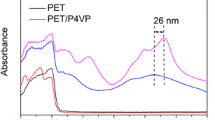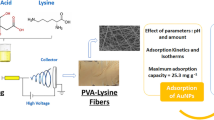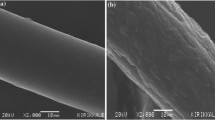Abstract
In this research, 4-Vinyl pyridine grafted poly(ethylene terephthalate), (4VP-g-PET), fibers were synthesized using the radical polymerization method and used as a novel adsorbent for removing selenite (SeO32−) ions from aqueous solutions. SEM and FTIR spectroscopy were used to examine the structure of the synthesized fibers. Batch experiments were used to conducted the adsorption research. Parameters affecting the adsorption performance like pH, grafting yield, adsorption time, initial selenite concentration and temperature were investigated. The best removal of selenite ions was attained at pH 6. Interestingly, the fibers displayed significant adsorption potential at higher pHs even in highly alkaline environments. Within 3 h, adsorption equilibrium was established, and kinetically, the adsorption process was found to obey the pseudo-first-order kinetic model. Grafting yield increased the amount of selenium adsorption up to 47 percent. The synthesized fibers’ maximum selenite adsorption ability was found to be 26.91 mg g−1. Thermodynamic parameters ΔH0, ΔS0 and ΔG0 of the adsorption were also calculated. The adsorption reaction was determined to be exothermic. The possible adsorption routes were proposed. The synthetic adsorbent, 4VP-g-PET fibers, may be a promising alternative adsorbent for removing selenite from aqueous media.










Similar content being viewed by others
References
He Y, Xiang Y, Zhou Y, Yang Y, Zhang J, Huang H, Shang C, Luo L, Gao J, Tang L (2018) Selenium contamination, consequences and remediation techniques in water and soils: a review. Environ Res 164:288–301. https://doi.org/10.1016/j.envres.2018.02.037
Awual MR, Hasan MM, Khaleque MA (2015) Efficient selenium(IV) detection and removal from water by tailor-made novel conjugate adsorbent. Sens Actuators B Chem 209:194–202. https://doi.org/10.1016/j.snb.2014.11.010
Maier KJ, Foe CG, Knight AW (1993) Comparative toxicity of selenate, selenite, seleno-DL-methionine, and seleno-DL-cystine to Daphia Magna. Environ Toxicol Chem 12(4):755–763. https://doi.org/10.1002/etc.5620120417
Painter EP (1941) The chemistry and toxicity of selenium compounds with special reference to the selenium problem. Chem Rev 28(2):179–213. https://doi.org/10.1021/cr60090a001
Saad D, Cukrowska E, Tutu H (2013) Modified cross-linked polyethylenimine for the removal of selenite from mining wastewaters. Toxicol Environ Chem 95(3):409–421. https://doi.org/10.1080/02772248.2013.790971
Skorupa JP (1998) Selenium poisoning of fish and wildlife in nature: lessons from twelve real-world examples. In: Frankenburger WT, Engberg RA (eds) Environmental Chemistry of Selenium. Marcel Dekker, New York, pp 315–354
Conley JM, Funk DH, Buchwalter DB (2009) Selenium bioaccumulation and maternal transfer in the mayfly centroptilum triangulifer in a life-cycle, periphyton-biofilm trophic assay. Environ Sci Technol 43:7952–7957. https://doi.org/10.1021/es9016377
DeForest DK, Gilron G, Armstrong SA, Robertson EL (2011) Species sensitivity distribution evaluation for selenium in fish eggs: considerations for development of a Canadian tissue-based guideline. IEAM 8(1):6–12. https://doi.org/10.1002/ieam.245
Kawamatu D, Yamanishi Y, Ohashi H, Yonezu K, Honma T, Sugiyama T, Kobayashi Y, Okaue Y, Miyazaki A, Yokoyama T (2019) A new and practical Se(IV) removal method using Fe3+ type cation exchange resin. J Hazard Mater 378:120593. https://doi.org/10.1016/j.jhazmat.2019.04.076
Wu L (2004) Review of 15 years of research on ecotoxicology and remediation of land contaminated by agricultural drainage sediment rich in selenium. Ecotoxicol Environ Saf 57(3):257–269. https://doi.org/10.1016/S0147-6513(03)00064-2
Ackerman JT, Eagles-Smith CA, Herzog MP, Hartman CA (2016) Maternal transfer of contaminants in birds: mercury and selenium concentrations in parents and their eggs. Environ Pollut 210:145–154. https://doi.org/10.1016/j.envpol.2015.12.016
Basu R, Haque SE, Tang J, Ji J, Johannesson KH (2007) Evolution of selenium concentrations and speciation in groundwater flow systems: upper floridan (florida) and carrizo sand (texas) aquifers. Chem Geol 246(3–4):147–169. https://doi.org/10.1016/j.chemgeo.2007.09.010
Brady C, Petrie S, Schummer M, Badzinski S, Belzile N, Chen Y-W (2013) Effects of dietary selenium on the health and survival of captive wintering lesser scaup. Environ Pollut 175:8–15. https://doi.org/10.1016/j.envpol.2012.12.005
King KA, Custer TW, Weaver DA (1994) Reproductive success of barn swallows nesting near a selenium-contaminated lake in east Texas, USA. Environ Pollut 84(1):53–58. https://doi.org/10.1016/0269-7491(94)90070-1
Pasan CB, Jem-Valerie DP, Enrico TN, Raj GN, Konrad JK, Debora FR (2010) Graphene oxide nanocomposite hydrogel beads. ACS Appl Polym Mater 1(10):2668–2679. https://doi.org/10.1021/acsapm.9b00612
Ware LL, Petrie SA, Bailey RC, Badzinski SS, Schummer ML, Chen Y-W, Belzile N (2012) Effects of elevated selenium on body condition, oxidative stress, and organ health in greater scaup wintering at Lake Ontario. J Wildl Manage 36(3):506–511. https://doi.org/10.1002/wsb.158
Lee KH, Jeong D (2012) Bimodal actions of selenium essential for antioxidant and toxic pro-oxidant activities: the selenium paradox. Mol Med Rep 5(2):299–304. https://doi.org/10.3892/mmr.2011.651
In EPA 816-F-09-004 (2009) National primary drinking water regulaion table. Agency, U. S. E. P., Ed. p 7. https://www.epa.gov/sites/production/files/2016-06/documents/npwdr_complete_table.pdf
Santos S, Ungureanu G, Boaventura R, Botelho C (2015) Selenium contaminated waters: an overview of analytical methods, treatment options and recent advances in sorption methods. Sci Total Environ 521–522:246–260. https://doi.org/10.1016/j.scitotenv.2015.03.107
Winkel LHE, Johnson CA, Lenz M, Grundl T, Leupin OX, Amini M, Charlet L (2012) Environmental selenium research: from microscopic processes to global understanding. Environ Sci Technol 46(2):571–579. https://doi.org/10.1021/es203434d
Lounsbury AW, Yamani JS, Johnston CP, Larese-Casanova P, Zimmerman JB (2016) The role of counter ions in nano-hematite synthesis: implications for surface area and selenium adsorption capacity. J Hazard Mater 310:117–124. https://doi.org/10.1016/j.jhazmat.2016.01.078
Córdoba P, Ochoa-Gonzalez R, Font M, Izquierdo O, Querol X, Leiva C, López-Antón MA, Díaz-Somoano M, Martinez-Tarazona MR, Fernandez C, Tomás A (2012) Partitioning of trace inorganic elements in a coal-fired power plant equipped with a wet flue gas desulphurisation system. Fuel 92(1):145–157. https://doi.org/10.1016/j.fuel.2011.07.025
Fukushi K, Miyashita S, Kasama T, Takahashi Y, Morodome S (2019) Superior removal of selenite by periclase during transformation to brucite under high-pH conditions. J Hazard Mater 371:370–380. https://doi.org/10.1016/j.jhazmat.2019.02.107
Vinceti M, Crespi CM, Bonvicini F, Malagoli C, Ferrante M, Marmiroli S, Stranges S (2013) The need for a reassessment of the safe upper limit of selenium in drinking water. Sci Total Environ 443:633–642. https://doi.org/10.1016/j.scitotenv.2012.11.025
Limchoowong N, Sricharoen P, Chanthai S (2019) A novel bead synthesis of the Chiron-sodium dodecyl sulfate hydrogel and its kinetics-thermodynamics study of superb adsorption of alizarin red S from aqueous solution. J Polym Res 26:265. https://doi.org/10.1007/s10965-019-1944-9
Balistrieri LS, Chao TT (1990) Adsorption of selenium by amorphous iron oxyhydroxide and manganese dioxide. Geochim Cosmochim Acta 54(3):739–751. https://doi.org/10.1016/0016-7037(90)90369-V
Glasauer S, Doner HE, Gehring AU (1995) Adsorption of selenite to goethite in a flow through reaction chamber. J Soil Sci Plant Nutr 46(1):47–52. https://doi.org/10.1111/j.1365-2389.1995.tb01811.x
EI-Shafey EI, (2007) Sorption of Cd(II) and Se(IV) from aqueous solution using modified rice husk. J Hazard Mater 147(1–2):546–555. https://doi.org/10.1016/j.jhazmat.2007.01.051
Zhang N, Lin L-S, Gang D (2008) Adsorptive selenite removal from water using iron-coated GAC adsorbents. Water Res 42(14):3809–3816. https://doi.org/10.1016/j.watres.2008.07.025
Kashiwagi Y, Kokufuta E (2000) Selective determination of selenite and selenate in wastewater by graphite furnace AAS after iron(III) hydroxide coprecipitation and reductive coprecipitation on palladium collector using hydrazinium sulfate. Anal Sci 16(11):1215–1219. https://doi.org/10.2116/analsci.16.1215
Li J, Wang X, Zhao G, Chen C, Chai Z, Alsaedi A, Hayat T, Wang X (2018) Metal−organic framework-based materials: superior adsorbents for the capture of toxic and radioactive metal ions. Chem Soc Rev 47:2322–2356. https://doi.org/10.1039/C7CS00543A
Cui W, Li P, Wang Z, Zheng S, Zhang Y (2018) Adsorption study of selenium ions from aqueous solutions using MgO nanosheets synthesized by ultrasonic method. J Hazard Mater 341:268–276. https://doi.org/10.1016/j.jhazmat.2017.07.073
Xiao W, Yan B, Zeng H, Liu Q (2016) Dendrimer functionalized graphene oxide for selenium removal. Carbon 105:655–664. https://doi.org/10.1016/j.carbon.2016.04.057
Holmes AB, Gu FX (2016) Emerging nanomaterials for the application of selenium removal for wastewater treatment. Environ Sci Nano 3:982–996. https://doi.org/10.1039/C6EN00144K
Fu Y, Wang J, Liu Q, Zeng H (2014) Water-dispersible magnetic nanoparticle−graphene oxide composites for selenium removal. Carbon 77:710–721. https://doi.org/10.1016/j.carbon.2014.05.076
Temoçin Z, Yiğitoğlu M (2010) Studies on selective uptake behavior of Hg(II) and Pb(II) by functionalized poly(ethylene terephthalate) fiber with 4-vinyl pyridine/2-hydroxyethylmethacrylate. Water Air Soil Pollut 210:463–472. https://doi.org/10.1007/s11270-009-0271-x
Arslan M, Günay K (2017) Synthesis and characterization of pet fibers grafted with binary mixture of 2-methylpropenoic acid and acrylonitrile by free radical: its application in removal of cationic dye. Polym Bull 74:1221–1236. https://doi.org/10.1007/s00289-016-1773-5
Arslan M, Günay K (2018) Synthesis of amine-functionalized methacrylic acid-g-poly(ethylene terephthalate) fiber and its congo red removal ability. Polym Bull 75:1701–1713. https://doi.org/10.1007/s00289-017-2121-0
Gün Gök Z, Günay K, Arslan M, Yiğitoğlu M (2019) Removing of congo red from aqueous solution by 2-hydroxyethyl methacrylate-g-poly(ethylene terephthalate) fibers. Polym Bull 76:6179–6191. https://doi.org/10.1007/s00289-019-02721-2
Coşkun R, Birgül H, Delibaş A (2018) Synthesis of functionalized PET fibers by grafting and modification and their application for Cr(VI) ion removal. J Polym Res 25:29. https://doi.org/10.1007/s10965-017-1429-7
Günay K, Arslan M, Bozkaya O, Aluç Y, Gün Gök Z (2019) Elimination of carcinogenic bromate ions from aqueous environment with 4-vinyl pyridine-g-poly(ethylene terephthalate) fibers. Environ Sci Pollut Res 26:31644–31653. https://doi.org/10.1007/s11356-019-06316-2
Ünlü N, Günay K, Arslan M (2020) Efficient removal of cationic dyes from aqueous solutions using a modified poly(ethylene terephthalate) fibers adsorbent. Polym Plast Tech Mat 59(5):527–535. https://doi.org/10.1080/25740881.2019.1669650
Bozkaya O, Günay K, Arslan M, Gün Gök Z (2021) Removal of anionic dyes with glycidyl methacrylate-grafted polyethylene terephthalate (PET) fibers modified with ethylenediamine. Res Chem Intermed 47:2075–2093. https://doi.org/10.1007/s11164-021-04398-7
Arslan M, Yiğitoğlu M, Soysal A (2006) Removal of chromium (VI) from aqueous solutions using poly(4-vinyl pyridine) beads. J Appl Polym Sci 101:2865–2870. https://doi.org/10.1002/app.23333
Arslan M, Günay K (2019) Application of 4-VP-g-PET fibers and its n-oxide derivative as an adsorbent for removal of cationic dye. Polym Bull 76:953–965. https://doi.org/10.1007/s00289-018-2400-4
Yiğitoğlu M, Arslan M (2005) Adsorption of hexavalent chromium from aqueous solutions using 4-vinyl pyridine grafted poly(ethylene terephthalate) fibers. Polym Bull 55:259–268. https://doi.org/10.1007/s00289-005-0440-z
Coşkun R, Er E, Delibaş A (2018) Synthesis of novel resin containing carbamothiolylimidamide group and application for Cr(VI) removal. Polym Bull 75:963–983. https://doi.org/10.1007/s00289-017-2068-1
Mittal H, Alhassana SM, Ray SS (2018) Efficient organic dye removal from wastewater by magnetic carbonaceous adsorbent prepared from corn starch. J Environ Chem Eng 6(6):7119–7131. https://doi.org/10.1016/j.jece.2018.11.010
Mittal H, Ray SS (2016) A study on the adsorption of methylene blue onto gum ghatti/TiO2 nanoparticles-based hydrogel nanocomposite. Int J Biol Macromol 88:66–80. https://doi.org/10.1016/j.ijbiomac.2016.03.032
Svecova L, Dossot M, Cremel S, Simonnot MO, Sardin M, Humbert B, Den Auwer C, Michot LC (2011) Sorption of selenium oxyanions on TiO2 (rutile) studied bybatch or column experiments and spectroscopic methods. J Hazard Mater 189(3):764–772. https://doi.org/10.1016/j.jhazmat.2011.02.090
Myneni SCB, Traina SJ, Logan TJ, Waychunas GA (1997) Oxyanion behavior in alkaline environments: sorption and desorption of arsenate in ettringite. Environ Sci Technol 31(6):1761–1768. https://doi.org/10.1021/es9607594
Sverjensky DA, Fukushi K (2006) Anion adsorption on oxide surfaces: inclusion of the water dipole in modeling the electrostatics of ligand exchange. Environ Sci Technol 40(1):263–271. https://doi.org/10.1021/es051521v
Coşkun R, Soykan C, Saçak M (2006) Adsorption of copper (II), nickel (II) and cobalt (II) ions from aqueous solution by methacrylic acid/acrylamide monomer mixture grafted poly (ethylene terephthalate) fiber. Sep Purif Technol 49(2):107–114. https://doi.org/10.1016/j.seppur.2005.09.002
Rahman N, Dafader NC, Shakhawat Hossen M, Alam MF, Kabir M, Rakibul Hasan M (2016) Gamma ray induced grafting of binary monomers (acrylic acid/methyl methacrylate) onto polyethylene(PE) films for heavy metal adsorption. J Mater Environ Sci 7(10):4096–4104
Yiğitoğlu M, Arslan M (2009) Selective removal of Cr(VI) ions from aqueous solutions including Cr(VI), Cu(II) and Cd(II) ions by 4-vinyl pyridine/2-hydroxyethylmethacrylate monomer mixture grafted poly(ethylene terephthalate) fiber. J Hazard Mater 166(1):435–444. https://doi.org/10.1016/j.jhazmat.2008.11.075
Yang Y, Ding Q, Wen D, Yang M, Wang Y, Liu N, Zhang X (2018) Bromate removal from aqueous solution with novel flower-like Mg-Al-layered double hydroxides. Environ Sci Pollut Res 25:27503–27513. https://doi.org/10.1007/s11356-018-2781-9
Legergren S (1898) About the theory of so-called adsorption of soluble substances. Kungl Svenska Vetenskapsakad Handl 24:1–39
Ho YS, McKay G (1999) Pseudo-second order model for sorption processes. Process Biochem 34:451–465. https://doi.org/10.1016/S0032-9592(98)00112-5
Weber WJ, Morris JC (1963) Kinetics of adsorption on carbon from solution. J Sanit Eng Div Proc Am Soc Civ Eng 89:31–59. https://doi.org/10.1061/JSEDAI.0000430
Kantipuly G, Katragadda S, Chow A, Gesser HD (1990) Chelating polymersand related supports for separation and preconcentration of trace metals. Talanta 37(5):491–517. https://doi.org/10.1016/0039-9140(90)80075-Q
Ünlü N, Ersöz M (2006) Adsorption characteristics of heavy metal ions onto a low costbiopolymeric sorbent from aqueous solutions. J Hazard Mater 136(2):272–280. https://doi.org/10.1016/j.jhazmat.2005.12.013
Seyed Dorraji MS, Amani-Ghadim AR, Hanifehpour Y, Woo Joo S, Figoli A, Carraro M, Tasselli F (2017) Performance of chitosan based nanocomposite hollow fibers in the removal of selenium (IV) from water. Chem Eng Res Des 117:309–317. https://doi.org/10.1016/j.cherd.2016.10.043
Meher AK, Jadhav A, Labhsetwar N, Bansiwal A (2020) Simultaneous removal of selenite and selenate from drinking water using mesoporous activated alumina. Appl Water Sci 10:10. https://doi.org/10.1007/s13201-019-1090-x
Evans SF, Ivancevic MR, Yan J, Naskar AK, Levine AM, Lee RJ, Tsouris C, Paranthaman MP (2019) Magnetic adsorbents for selective removal of selenite from contaminated water. Sep Sci Technol 54(13):2138–2146. https://doi.org/10.1080/01496395.2019.1617742
Wang R, Xu H, Zhang K, Wei S, Wu D (2019) High-quality Al@Fe-MOF prepared using Fe-MOF as a micro-reactor toimprove adsorption performance for selenite. J Hazard Mater 364:272–280. https://doi.org/10.1016/j.jhazmat.2018.10.030
Langmuir I (1908) Adsorption of gases on plane surfaces of glass mica platinum. J Am Chem Soc 40(9):1361–1403. https://doi.org/10.1021/ja02242a004
Freundlich HMF (1906) Over the adsorption in solution. J Phy Chem 57:385–470
Bağ H, Türker AR, Coşkun R, Saçak M, Yiğitoğlu M (2000) Determination of zinc, cadmium, cobalt and nikel by flame atomic absorption spectrometry after preconcentration by poly(ethylene terephthalate) fibers grafted with methacrylic acid. Spectrochim Acta Part B At Spectrosc 55(7):1101–1108
Author information
Authors and Affiliations
Corresponding author
Ethics declarations
Conflict of interest
The authors declare that they have no known competing financial interests or personal relationships that could have appeared to influence the work reported in this paper.
Additional information
Publisher's Note
Springer Nature remains neutral with regard to jurisdictional claims in published maps and institutional affiliations.
Rights and permissions
About this article
Cite this article
Arslan, M., Yılmaz, M.N., Günay, K. et al. Removing selenite ions (SeO32−) from aqueous solutions by 4-vinyl pyridine monomer grafted poly(ethylene terephthalate) fibers and an estimation of its adsorption mechanism over pH dependency of the adsorption. Polym. Bull. 80, 3135–3152 (2023). https://doi.org/10.1007/s00289-022-04205-2
Received:
Revised:
Accepted:
Published:
Issue Date:
DOI: https://doi.org/10.1007/s00289-022-04205-2




